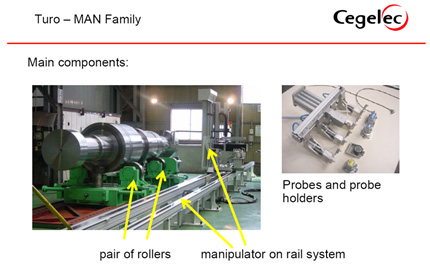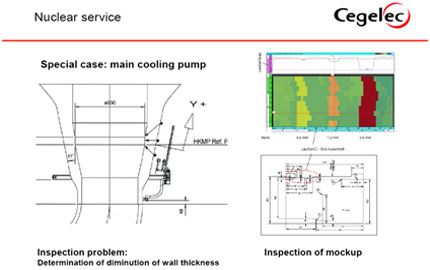Non-Destructive Test Equipment
Inspection performed without changing the original shape and function
Non-Destructive Test Equipment
Inspection performed without changing the original shape and function
Non-Destructive Test Equipment
What is Non-Destructive Testing?
The application of physical energy (sunlight, heat; It refers to any test that studies the abnormalities or degree of defect in the tissue by measuring the amount of change in these properties using an appropriate transducer when the properties and characteristics of the applied energy change due to the presence of abnormalities or defects in the tissue. The test can be conducted by applying physical energy (sunlight, heat, radiation, sound wave, electricity and magnetic energy) to a material or a product without changing its original shape and function for observation.
We supply Cegelec’s Ultrasonic Testing (UT) equipment from Germany to detect mechanical defects in large castings. For proper detection, high frequency (1MHz~25MHz) ultrasonic waves, which is capable of detecting the size and position, are transmitted through the subject and they detect the size and position of defects with the ultrasonic beam reflected from the discontinuity (CRACK, machining.)
We supply Cegelec’s Ultrasonic Testing (UT) equipment from Germany to detect mechanical defects in large castings. For proper detection, high frequency (1MHz~25MHz) ultrasonic waves, which is capable of detecting the size and position, are transmitted through the subject and they detect the size and position of defects with the ultrasonic beam reflected from the discontinuity (CRACK, machining.)
Non-Destructive Testing (NDT) Trends
• In developed countries, the utilization of Ultrasonic Testing (UT) and Magnetic Particles Testing (MT) accounts for 50% more of the total NDT.
• The majority of the NDT companies are conducting RT (Radiography Testing), but its use is gradually decreasing, and the application trend of UT (Ultrasonic Testing) is on the rise.
• The majority of the NDT companies are conducting RT (Radiography Testing), but its use is gradually decreasing, and the application trend of UT (Ultrasonic Testing) is on the rise.
Product Type – Large Forging or Energy-Related Mechanical Inspection System
Product Type – Inspection Systems for Nuclear Fields
Purpose of Non-Destructive Testing (NDT)
1. Improvement of reliability
Basically, increasing the reliability regarding the stability of parts (materials) is the most important. Extending life through periodic Non-Destructive Testing can increase the performance and reliability of materials.
2. Improvement of manufacturing technology
The analysis of results based on periodic Non-Destructive Testing (NDT) can lead to changes in the manufacturing conditions for the production of better products and can contribute to creating better products overall.
3. Cost Reduction/Accident Prevention
Defects that are invisible to the naked eye can be detected at an early stage, which allows for defective products to be detected early. This prevents major defects from occurring in advance, thus leading to cost reduction.







